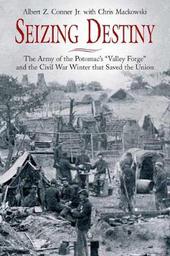
|
Seizing Destiny: The Army of the Potomac's "Valley Forge" and the Civil War Winter That Saved the Union
Hardback
Main Details
| Title |
Seizing Destiny: The Army of the Potomac's "Valley Forge" and the Civil War Winter That Saved the Union
|
| Authors and Contributors |
By (author) Albert Z. Conner
|
|
By (author) Chris Mackowski
|
| Physical Properties |
| Format:Hardback | | Pages:480 | | Dimensions(mm): Height 229,Width 152 |
|
| Category/Genre | American civil war |
|---|
| ISBN/Barcode |
9781611211566
|
| Classifications | Dewey:973.73 |
|---|
| Audience | | Professional & Vocational | |
|---|
| Illustrations |
18 images, 2 maps
|
|
Publishing Details |
| Publisher |
Savas Beatie
|
| Imprint |
Savas Beatie
|
| NZ Release Date |
11 May 2016 |
| Publication Country |
United States
|
Description
Depression. Desertion. Disease. The Army of the Potomac faced a trio of unrelenting enemies during the winter of 1863. Following the catastrophic defeat at the battle of Fredericksburg in December of 1862, the army settled into winter quarters-and despair settled into the army. Morale sank to its lowest level of the war while desertions reached an all-time high. Illness packed the hospitals. Political intrigues, careerist schemes, and harsh winter weather demoralised everyone. Major General Joseph Hooker, a pugnacious tactician aptly nicknamed"Fighting Joe," took command of the army. And then a remarkable thing happened: a man known for his hardscrabble battlefield tenacity showed an amazing brilliance for organisation and leadership. With Chief of Staff Dan Butterfield working alongside him, Hooker literally rebuilt the army from the bottom up. In addition to instituting vital logistical, ordnance, and administrative reforms, he insisted on proper troop care and rigourous inspections and battle drills. Hooker doled out promotions and furloughs by merit, conducted large-scale raids, streamlined the army's command and control, and fielded a new cavalry corps and military intelligence organisation. Hooker's war on poor discipline and harsh conditions revitalised a dying army and instilled individual and unit pride. During this 93-day resurgence, the Army of the Potomac reversed its fortunes and set itself on the path to ultimate victory. No other American citizen-army at war has engineered a more complete turnaround in the field. Hooker's achievement represents nothing less than the greatest non-battle turning point since Valley Forge in the American Revolution-a linkage recognised by hundreds of contemporary soldiers. Seizing Destiny: The Army of the Potomac's"Valley Forge" is the first in-depth examination of one of the war's true crucial turning points, a time when the army nearly dissolved from its own despair. The result is a rich and satisfying portrait of an overlooked success story that made Appomattox Court House in 1865 possible. Here, finally, is the full story of how the citizen-soldiers of the Army of the Potomac overcame adversity, seized their destiny, and saved the nation through leadership, perseverance, patriotism, and faith.
Author Biography
Albert Z. Conner Jr., a graduate of the Virginia Military Institute (VMI) and Georgetown University, is a Vietnam combat veteran and career intelligence officer. He has worked as a military historian since 1995. He developed his unique knowledge and analytical skills by studying the armed forces of several nations (including our own). Al has published extensively on multiple aspects of military history. He is a former president of the Fredericksburg Civil War Roundtable and Stafford County Historical Society, advisory board member of the Adams '71 Center for Military History and Strategic Analysis at VMI, and a volunteer with the Fredericksburg and Spotsylvania National Military Park. He lives in Stafford, Virginia, the scene of this remarkable story. Chris Mackowski, Ph.D., is a professor in the School of Journalism and Mass Communication at St. Bonaventure University in Allegany, New York, and also works with the National Park Service at Fredericksburg and Spotsylvania National Military Park, which includes the Fredericksburg, Chancellorsville, Wilderness, and Spotsylvania battlefields. He has published extensively on the Civil War and is the co-founder of the blog Emerging Civil War (www.emergingcivilwar.com).
|